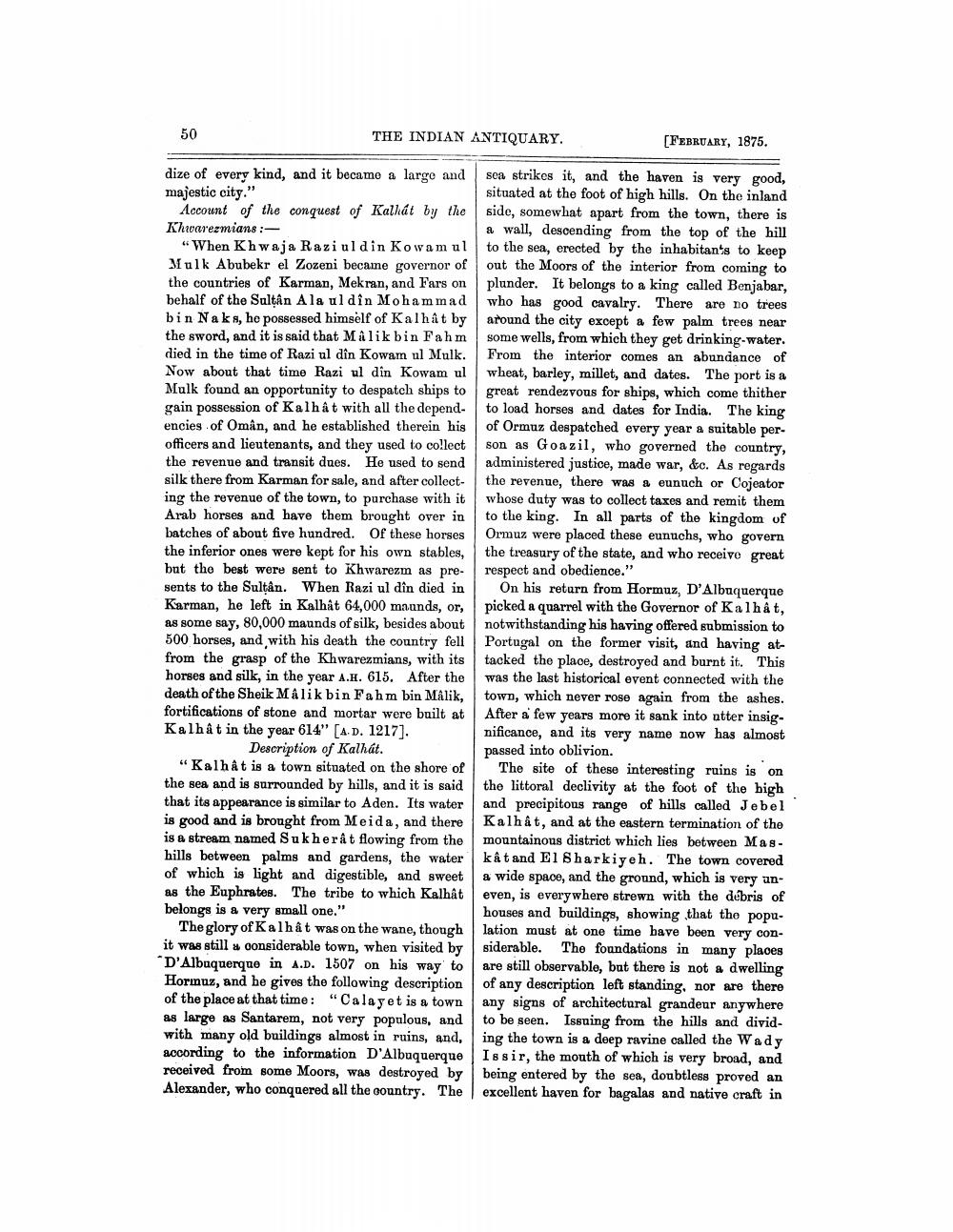________________
50
THE INDIAN ANTIQUARY.
dize of every kind, and it became a large and majestic city."
Account of the conquest of Kalhát by the side, somewhat apart from the town, there is Khwarezmians:a wall, descending from the top of the hill to the sea, erected by the inhabitants to keep out the Moors of the interior from coming to plunder. It belongs to a king called Benjabar, who has good cavalry. There are no trees around the city except a few palm trees near some wells, from which they get drinking-water. From the interior comes an abundance of wheat, barley, millet, and dates. The port is a great rendezvous for ships, which come thither to load horses and dates for India. The king of Ormuz despatched every year a suitable person as Goazil, who governed the country, administered justice, made war, &c. As regards the revenue, there was a eunuch or Cojeator whose duty was to collect taxes and remit them to the king. In all parts of the kingdom of Ormuz were placed these eunuchs, who govern the treasury of the state, and who receive great respect and obedience."
On his return from Hormuz, D'Albuquerque picked a quarrel with the Governor of Kalhat, notwithstanding his having offered submission to Portugal on the former visit, and having attacked the place, destroyed and burnt it. This was the last historical event connected with the town, which never rose again from the ashes. After a few years more it sank into utter insignificance, and its very name now has almost passed into oblivion.
The site of these interesting ruins is on the littoral declivity at the foot of the high and precipitous range of hills called Jebel Kalhât, and at the eastern termination of the mountainous district which lies between Maskât and El Sharkiyeh. The town covered a wide space, and the ground, which is very uneven, is everywhere strewn with the debris of houses and buildings, showing that the population must at one time have been very considerable. The foundations in many places are still observable, but there is not a dwelling of any description left standing, nor are there any signs of architectural grandeur anywhere to be seen. Issuing from the hills and dividing the town is a deep ravine called the Wady Is sir, the mouth of which is very broad, and being entered by the sea, doubtless proved an excellent haven for bagalas and native craft in
"When Khwaja Raziul din Kowam ul Mulk Abubekr el Zozeni became governor of the countries of Karman, Mekran, and Fars on behalf of the Sultan Ala ul din Mohammad bin Naks, he possessed himself of Kalhât by the sword, and it is said that Mâlik bin Fahm died in the time of Razi ul dîn Kowam ul Mulk. Now about that time Razi ul din Kowam ul Mulk found an opportunity to despatch ships to gain possession of Kalhât with all the dependencies of Omân, and he established therein his officers and lieutenants, and they used to collect the revenue and transit dues. He used to send silk there from Karman for sale, and after collecting the revenue of the town, to purchase with it Arab horses and have them brought over in batches of about five hundred. Of these horses the inferior ones were kept for his own stables, but the best were sent to Khwarezm as presents to the Sultân. When Razi ul dîn died in Karman, he left in Kalhât 64,000 maunds, or, as some say, 80,000 maunds of silk, besides about 500 horses, and, with his death the country fell from the grasp of the Khwarezmians, with its horses and silk, in the year A.H. 615. After the death of the Sheik Mâlik bin Fahm bin Mâlik, fortifications of stone and mortar were built at Kalhât in the year 614" [A.D. 1217].
Description of Kalhát.
[FEBRUARY, 1875.
sea strikes it, and the haven is very good, situated at the foot of high hills. On the inland
"Kalhat is a town situated on the shore of the sea and is surrounded by hills, and it is said that its appearance is similar to Aden. Its water is good and is brought from Meida, and there is a stream named Sukherât flowing from the hills between palms and gardens, the water of which is light and digestible, and sweet as the Euphrates. The tribe to which Kalhât belongs is a very small one."
The glory of Kalhât was on the wane, though it was still a considerable town, when visited by "D'Albuquerque in A.D. 1507 on his way to Hormuz, and he gives the following description of the place at that time: "Calayet is a town as large as Santarem, not very populous, and with many old buildings almost in ruins, and, according to the information D'Albuquerque received from some Moors, was destroyed by Alexander, who conquered all the country. The




